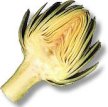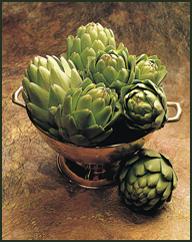|
 The globe
artichoke (Cynara scolymus), also called "French artichoke" and
"green artichoke," derives its common name from the northern Italian
words articiocco and articoclos. This
latter term is supposed to come from the Ligurian word cocali,
meaning a pine cone. The globe
artichoke (Cynara scolymus), also called "French artichoke" and
"green artichoke," derives its common name from the northern Italian
words articiocco and articoclos. This
latter term is supposed to come from the Ligurian word cocali,
meaning a pine cone.
The artichoke is a perennial in the
thistle group of the sunflower family and is believed to be a native
of the Mediterranean and the Canary Islands. In full growth, the plant
spreads to cover an area about size feet in diameter and reaches a
height of three to four feet. The "vegetable" that we eat is actually
the plant's flower bud. If allowed to flower, the blossoms measure up
to seven inches in diameter and are a beautiful violet-blue color.
 They are available
twelve months a year with the peak season in the spring and fall.
There are more than 140 artichoke varieties but less than 40 are grown
commercially. Today most artichokes grown worldwide are cultivated in
France, Italy, and Spain, while California provides nearly 100 percent
of the United States crop. One hundred percent of all artichokes grown
commercially in the United States are grown in California. Artichoke
fields are maintained in perennial culture for five to ten years. Each
cropping cycle is initiated by "cutting back" the tops of the plants
several inches below the soil surface to stimulate development of new
shoots. The operation called "stumping," is timed to regulate the new
harvest season. They are available
twelve months a year with the peak season in the spring and fall.
There are more than 140 artichoke varieties but less than 40 are grown
commercially. Today most artichokes grown worldwide are cultivated in
France, Italy, and Spain, while California provides nearly 100 percent
of the United States crop. One hundred percent of all artichokes grown
commercially in the United States are grown in California. Artichoke
fields are maintained in perennial culture for five to ten years. Each
cropping cycle is initiated by "cutting back" the tops of the plants
several inches below the soil surface to stimulate development of new
shoots. The operation called "stumping," is timed to regulate the new
harvest season.
Baby artichokes are not a separate variety but
merely smaller versions of larger artichokes. Their size comes from
their location on the artichoke plant. They are picked from the lower
parts of the artichoke plant where the plant fronds protect them from
sun, in effect stunting their growth.
 The healing power of
rainforest herbs, Alcachofra is the Brazilian name for the globe
artichoke. A member of the milk thistle family, it grows to a height
of about 2 m and produces a large, violet-green flower head. The
flower petals and fleshy flower bottoms are eaten as a vegetable
throughout the world, which has led to its commercial cultivation in
many parts of South and North America (chiefly California) as well as
in Europe. The artichoke was used as a food and medicine by the
ancient Egyptians, Greeks, and Romans; in Rome, the artichoke was an
important menu item at feasts. It wasn't until the fifteenth century,
however, that it made its appearance throughout Europe. The healing power of
rainforest herbs, Alcachofra is the Brazilian name for the globe
artichoke. A member of the milk thistle family, it grows to a height
of about 2 m and produces a large, violet-green flower head. The
flower petals and fleshy flower bottoms are eaten as a vegetable
throughout the world, which has led to its commercial cultivation in
many parts of South and North America (chiefly California) as well as
in Europe. The artichoke was used as a food and medicine by the
ancient Egyptians, Greeks, and Romans; in Rome, the artichoke was an
important menu item at feasts. It wasn't until the fifteenth century,
however, that it made its appearance throughout Europe.
Artichoke has been used in traditional medicine
for centuries as a specific liver and gallbladder remedy. In Brazilian
herbal medicine systems, leaf preparations are used for liver and
gallbladder problems, diabetes, high cholesterol, hypertension,
anemia, diarrhea (and elimination in general), fevers, ulcers, and
gout.
|